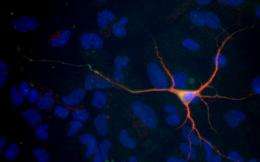Taking the fate of stem cells in hand: Researchers generate immature nerve cells

German biologists have deliberately transformed stem cells from the spinal cord of mice into immature nerve cells. This was achieved by changing the cellular environment, known as the extracellular matrix, using the substance sodium chlorate. Via sugar side chains, the extracellular matrix determines which cell type a stem cell can generate.
"Influencing precursor cells pharmacologically so that they transform into a particular type of cell can help in cell replacement therapies in future" says Prof. Dr. Stefan Wiese, head of the Molecular Cell Biology work group. "Therapies, for example, for Parkinson's, multiple sclerosis or amyotrophic lateral sclerosis could then become more efficient."
The team describes its findings in Neural Development.
Sulphate determines the fate of stem cells
Sodium chlorate acts on metabolism enzymes in the cell which attach sulphate groups to proteins. If these sulphates are not installed, the cell continues to form proteins for the extracellular matrix, but with modified sugar side chains. These chains in turn send out signals that define the fate of the stem cells. Stem cells can not only develop into nerve cells, but also form astrocytes or oligodendrocytes, which are, for instance, responsible for the mineral balance of the nerve cells or which form their insulation layer. What happens to the stem cells if the sulphate pattern is changed by sodium chlorate was examined by Dr. Michael Karus and his colleagues.
Positive side effects: nerve cells remain immature
The RUB-laboratories of Prof. Dr. Stefan Wiese, Prof. Dr. Andreas Faissner and Prof. Dr. Irmgard Dietzel-Meyer collaborated for the study. Using antibodies, the researchers showed that cells which they had treated with sodium chlorate developed into nerve cells. They also analysed the flow of sodium ions into the cells. The result: treated cells showed a lower sodium current than mature nerve cells. Sodium chlorate thus favours the development of stem cells into nerve cells, but, at the same time, also inhibits the maturation - a positive side effect, as Wiese explains: "If sodium chlorate stops the nerve cells in an early developmental phase, this could enable them to integrate into the nervous system following a transplant better than mature nerve cells would do."
More information: M. Karus, S. Samtleben, C. Busse, T. Tsai, I.D. Dietzel, A. Faissner, S. Wiese (2012): Normal sulphation levels regulate spinal cord neural precursor cell proliferation and differentiation, Neural Development, doi: 10.1186/1749-8104-7-20

















